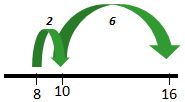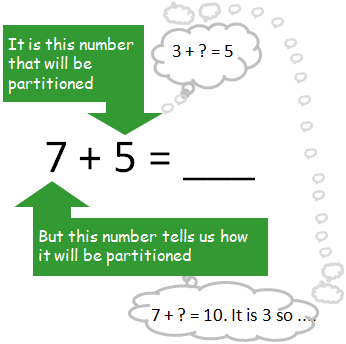There is a significant step-up required when moving from addition within 10 to addition within 20 and beyond. This is because students have to deal with both the relatively advanced concept of place value and with the illogical naming of teen numbers (e.g. twelve as opposite the more logical “tenty-two”). Although this lesson does not specifically address these two issues, it does show the making 10 strategy that can greatly assist with mental addition and subtraction with numbers above 10.
The most important thing to remember about the making 10 strategy is that it involves two steps. The first step is to the 10, the second is from the 10.

As shown above with the 8 + 8 example, the strategy involves partitioning the number to be added into two components so that one of these components gets us to 10. The remaining component is the step from the 10 and gets us to our answer.

Making 10 relies on being able to quickly recall the complements of 10 and the components of numbers up to 10. In other words these should be memorized. You will find more help with this here.
Making 10 with Cuisenaire Rods
It is a good idea to model the making 10 strategy using hands-on materials such as Cuisenaire Rods before moving on to using blank number lines and writing equations.
| Example: 7 + 5 | ||||||||
| Start by making a 5 sandwich.
Discuss what is in the sandwich! Put it to the side but still in view. |
|
|||||||
|
|
||||||||
| Place a black (7) and a yellow (5) end-to-end
|
||||||||
|
|
||||||||
| Place an orange (10) below the two rods
|
||||||||
|
|
||||||||
| Decide what two rods match the yellow. Use the 5 sandwich if needed. Do the swap.
|
||||||||
|
|
||||||||
Repeat the procedure shown in the example above and add 5 to other numbers. e.g. 8 + 5, 9 + 5. You can then move on and add other numbers. e.g. 7 + 6, 7 + 5, 7 + 4. There is a printable worksheet that uses Cuisenaire Rods to help make 10 that you can try after doing the hands-on activities.
Blank Number Line Examples
The two steps in the making 10 strategy can be practiced using a drawn or sketched line. Eventually, with practice, it should be possible to see the blank line and the two steps in your head.
Try not to use a number line with marks at intervals of 1 as this may encourage the inefficient counting by ones strategy that this strategy is intended to replace.
| Example: 8 + 5 |
Draw a number line and mark the position of 10 and the first, or starting number, 8

|
Make the first step to 10

|
Make the second step with whatever is leftover from the 5. In this case 3 which adds to 10 to get us to 13
 Discuss how 8 + 5 is the same as 8 + 2 + 3 which is the same as 10 + 3
Discuss how 8 + 5 is the same as 8 + 2 + 3 which is the same as 10 + 3 |
Practice Quiz
Try the quiz below to practice addition using the making 10 strategy.
![]() Bridging over 10 e.g. 8 + 5
Bridging over 10 e.g. 8 + 5
Making 10 Worksheets
- Addition with Making 10 and Cuisenaire Rods e.g. 9 + 4 = 9 + 1 + 3 = 10 + 3 = 13
- Making 10 e.g. 7 + 5, 6 + 6
With Subtraction
Think how you solve 13 – 8 mentally. Chances are you would think what you must add to 8 to get 13. This shows why the making 10 strategy can apply to subtraction as well as addition.
Note: Some students who struggle find working backwards on a number line to be very difficult. As the example below shows, we can work forward and make the subtraction problem into an addition problem. To succeed with this strategy for subtraction students must understand that 13 – 8 = __ can be re-written as 8 + __ = 13.
| Example: 13 – 8 |
| Draw a number line and mark the position of 13, 8, and 10
|
Start at 8. How far is it to 10?

|
How far is it from 10 to 13?
 Discuss how the difference between 13 and 8 is the total of the two steps (2 + 3 = 5).
Discuss how the difference between 13 and 8 is the total of the two steps (2 + 3 = 5). |
Making Multiples of 10
Students with good number sense and a solid understanding of place value should be able to extend the making 10 strategy to help work with larger numbers. However, students who struggle with math may require a slower introduction to making multiples of 10 as well as more assistance and practice. For example, more hands-on work with Cuisenaire Rods following on from those shown above will help students to progress their use of the strategy.
| Examples with Multiples of 10 |
|
49 + 6 = 55 
|
|
28 + 6 = 34 
|
You can practice making multiples of 10 with the Bridging Multiples of 10 worksheet e.g. 49 + 7, 66 + 8
There are many more addition and subtraction worksheets here. There is also a handy addition/ subtraction worksheet generator here.









